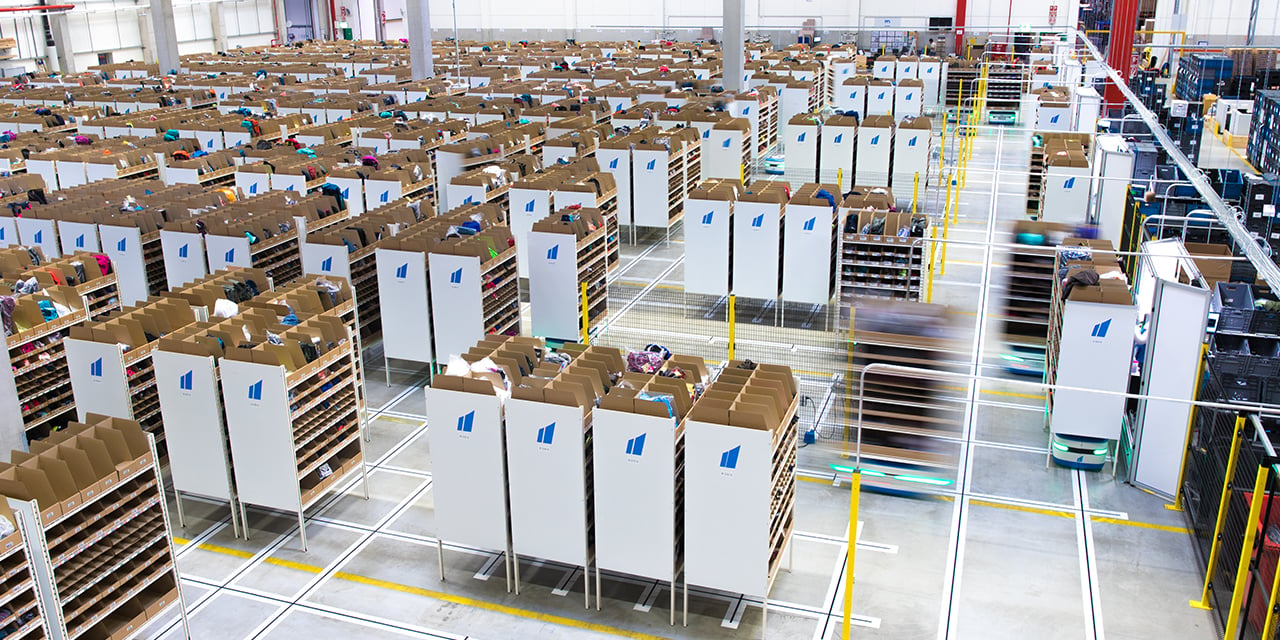Crises of recent years have transformed consumer habits and driven a significant expansion in online shopping. To cope with this, retailers and e-commerce players are moving towards an omnichannel logistics model where warehouses simultaneously manage order picking, returns and the restocking of different channels.
In this model, goods to man robotics is emerging as a key element in the transformations underway in retail logistics!
 With normal stores closed, lockdown saw an unprecedented boom in online sales in France.
With normal stores closed, lockdown saw an unprecedented boom in online sales in France.
But this growth has slowed, with the year 2022 signalling the end of the dizzying growth rates. However, this momentum has not completely disappeared, despite the economic situation. E-commerce growth in 2023 is expected to be 5% higher than before the pandemic, and to stabilise over the next few years.
The same phenomenon caused a surge in home delivery, a sharp increase in click and collect, and a similar expansion in “drive” services.
A growth that couldn’t have happened without the shift to digital in the buying habits of French consumers.
Social networks, e-commerce, points of sale: consumers are now adept at switching between several information or transaction channels.
We can call these shoppers omniconsumers. And they are increasingly demanding in terms of:
- product availability,
- delivery options,
- compliance with deadlines,
- quality of service.
As the economy comes back to life, retailers and e-commerce players will have to overcome the challenges represented by customer proximity and the need to standardize omnichannel logistics across their distribution centres.
To do so, logistics professionals will have to re-think their systems. They will also have to review processes in their logistics warehouses in order to:
- manage growing volumes of single-unit orders,
- accelerate order picking rates for next-day and same-day delivery,
- react quickly to changes in the product mix
- manage returns.
Simple and economical, automation - and more specifically goods to man robotics - is a sine qua non for adapting warehouses to new challenges in terms of responsiveness and customer proximity!
Goods to man: a solution to the challenges posed by omnichannel logistics?
With more and more “omniconsumers”, logistics warehouse handling logistics operations in all channels is the ideal way to optimize the customer experience while keeping costs under control.
An omnichannel warehouse has four principal missions :
- to store a large number of stock keeping units with highly variable rates of turnover
- to consolidate omnichannel order picking and make it more reliable
- to optimize management of returns
- to adapt to activity spikes (which occur ever more frequently).
Faced with the demands of consumers in terms of product availability, track and trace of orders and speed of delivery, logistics - and distribution centres especially - holds the key to customer satisfaction and loyalty.
Therefore, a distribution centre dedicated to “customer proximity ” must be capable of:
- processing more orders per day,
- ensuring seamless stock management (to avoid shortages or disruption) at all times
- tracing all workflows at every stage of order processing.
To these challenges we can now add the uncertainty - economic and health-related - which characterizes today’s world.
Subject to the constraints imposed on the one hand by the demands of customers and on the other by recent exceptional circumstances, the question every distribution centre asks itself is: How can we automate activity (and especially order picking, which is the costliest task of all) at the most advantageous cost?
In the logistics sector, one answer rings out loudest: goods to man.
Goods to man robotics brings the product to the operator. It builds on existing infrastructure by combining rigour, flexibility and agility to generate maximum ROI.
Productivity and service level: the advantages of goods to man robotics for an omnichannel warehouse
In an omnichannel warehouse, robotics helps:
- increase the productivity of order picking,
- ensure the necessary cost control,
- improve quality of service,
- and all of this within an ever more restrictive framework in terms of environmental and health requirements.
Robotics - enhancing the economic performance of omnichannel production
SCALLOG robots can carry mobile shelf units stacked with goods to a total weight of 600 kg.

Goods to man robotics obtains an average productivity gain of over 40% in order picking for low- and medium- turnover products.
With more than 230 lines processed per hour, this technology strikes the perfect balance between increased picking rates and operator well-being.
Operator well-being improves thanks to the elimination of legwork and the reduction of repetitive movements.
And with the SCALLOG system, robotics secures a 30% saving in storage space..
Omnichannel, robotics and service levels: lead times
Robotics improves productivity and continuity, and above all offers “ flawless ” order picking quality. As a reminder, more than 90% of picking errors are of human origin.
The goods to man system helps the operator select the right product in the right quantity to prepare retail orders as quickly as possible and deliver them to the right place, at the right time.
With the omnichannel model - characterized by short lead times (next day delivery, soon to be same day) - a goods to man robotics solution makes order picking more reliable so deadlines can be met and customer satisfaction guaranteed.
Robotics and resilience
As the economy emerges from the “ atypical “ circumstances of the Covid-19 pandemic, warehouses have been at the forefront of the changes re-shaping the commercial landscape.
Among them :
- the launch of new product lines, containing new types and sizes of product,
- the e-commerce boom, which has been accompanied by major changes in the structure of orders,
- more frequent activity spikes mean operations accumulate over very short periods of time.
To quickly respond to such changes, robotics has to be completely scalable without disrupting the existing installation. Additional robots, whether purchased or leased, need to be operational in a matter of hours.
Automation: respecting humans and the environment
The economic, social and public health circumstances make goods to man the best technology for operators.
Their workstations are increasingly ergonomic in design, which helps reduce the carbon footprint of their work - and make it less strenuous.
How? Because with goods to man, operators:
- no longer travel between 10 and 15 km daily
- no longer carry tons of weight (a source of fatigue and MSD) in a single shift
- benefit from the reduction in repetitive tasks and compliance with post-Covid health rules
The goods to man system is not only energy-efficient but “waste-free” too, for the robots' batteries can be recycled.
According to the WHO, global trade is expected to contract by 30% in the wake of the coronavirus pandemic.
And yet the crisis may also serve to stimulate warehouse robotics in the efforts of the logistics sector to meet new consumer demands, optimize costs and make supply chains more robust. It’s our view that brands with increasingly personalized value propositions - including in logistics - will better optimize their customer experience and secure the sustainable growth of their businesses.





Laisser nous votre commentaire